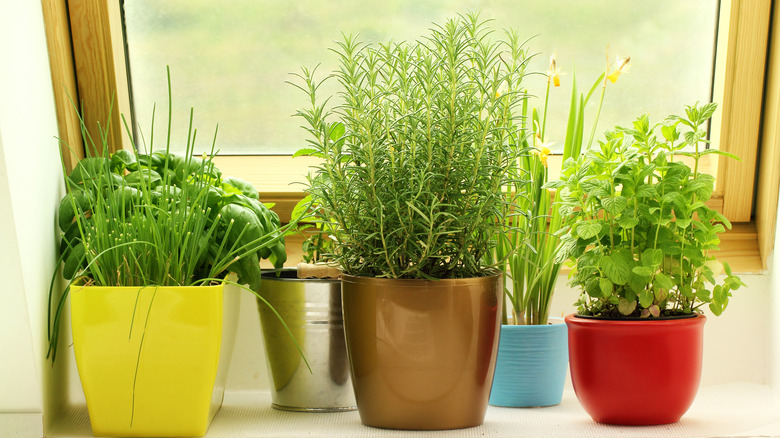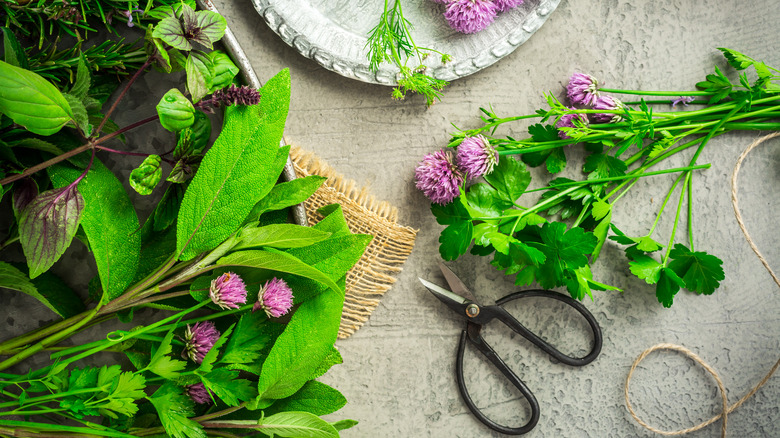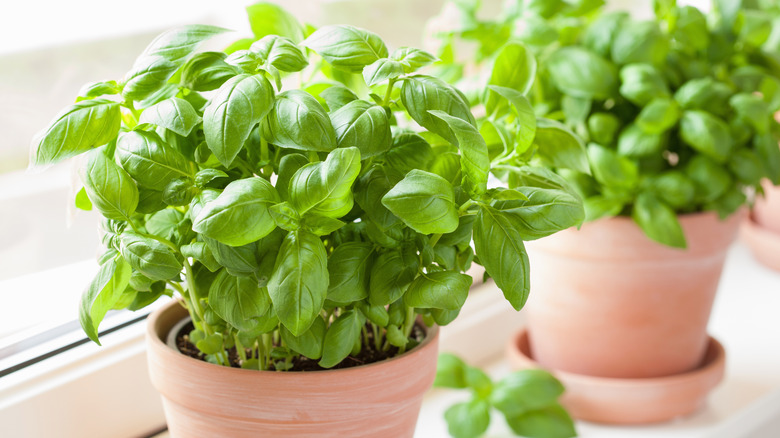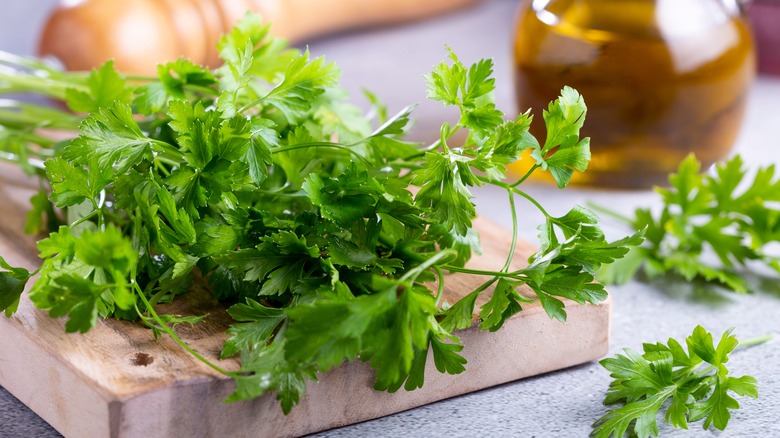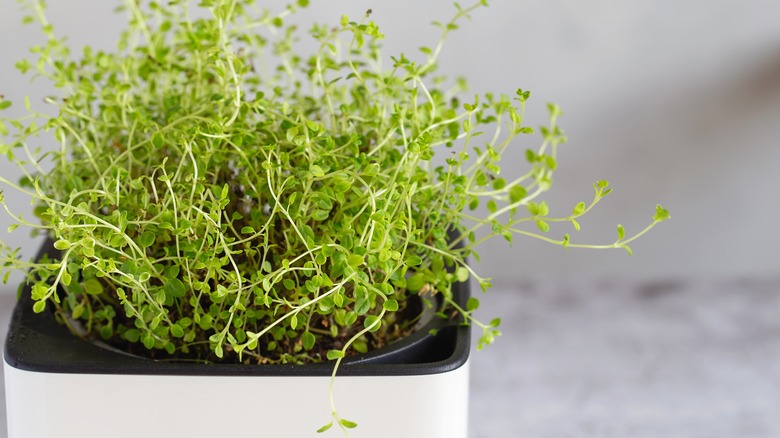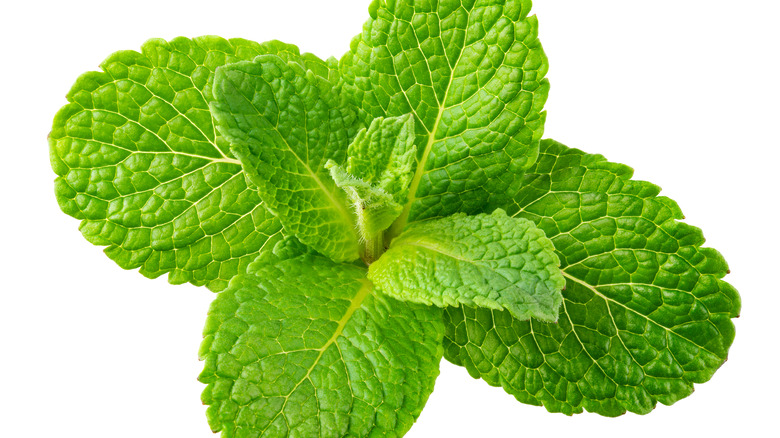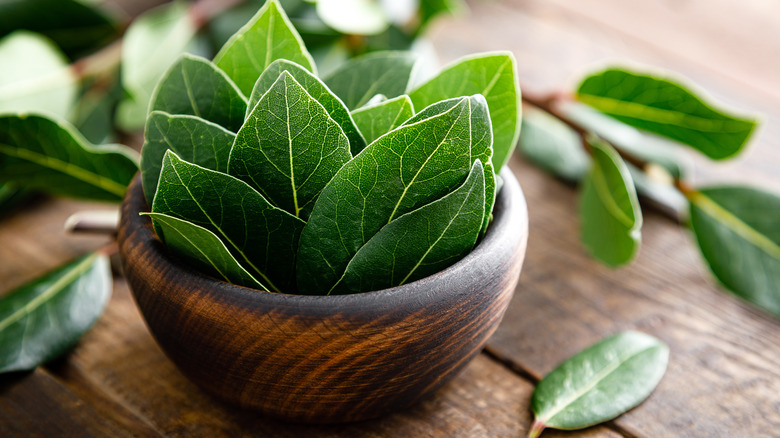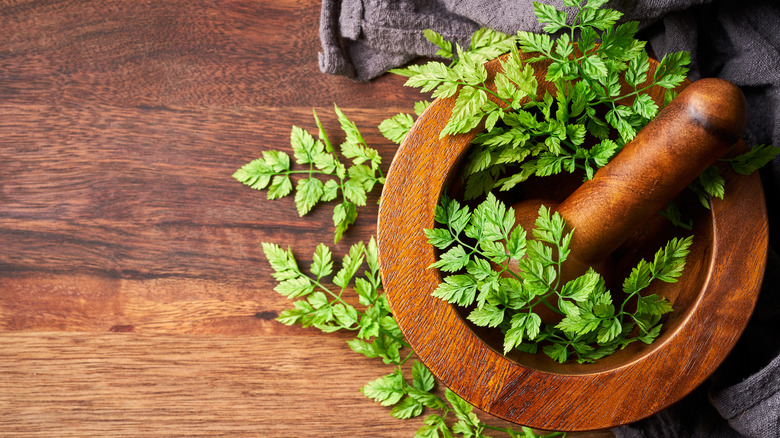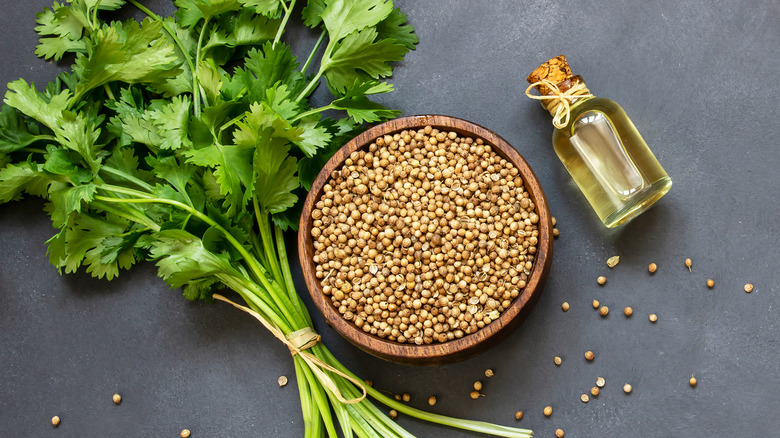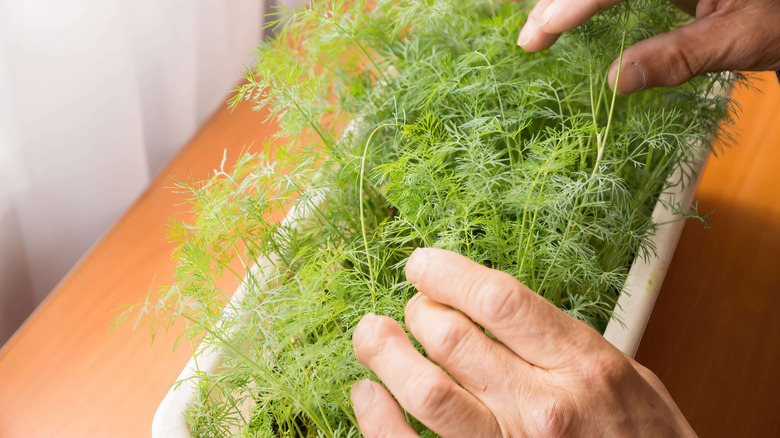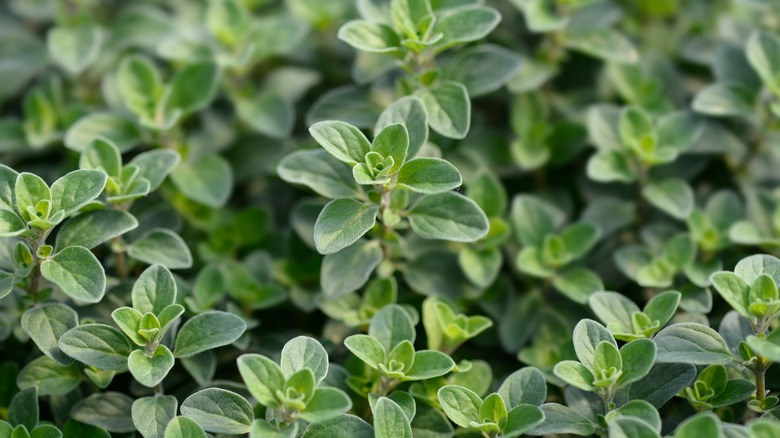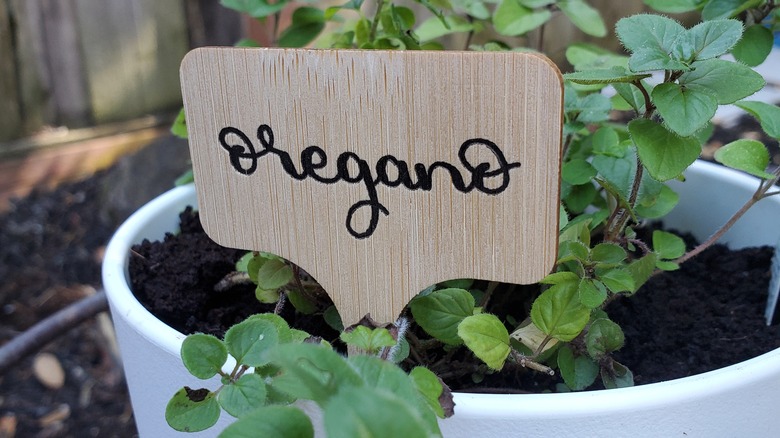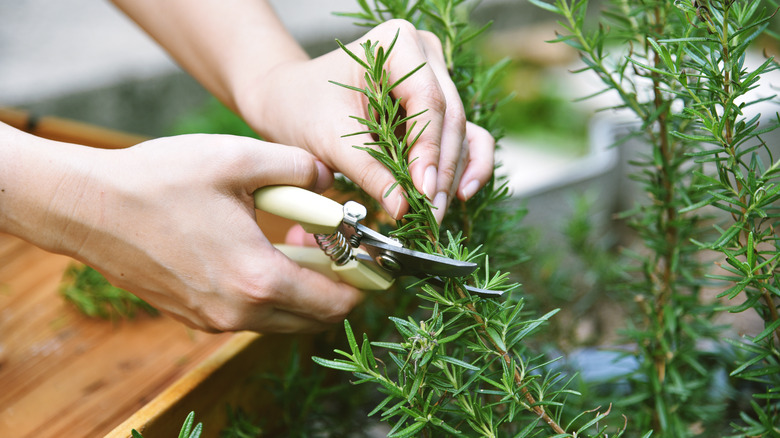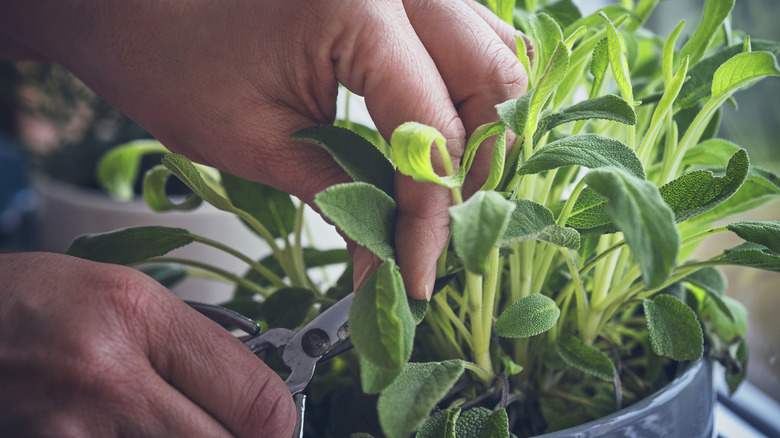The 13 Best Indoor Herbs For Your Kitchen Garden
Herbs are a delicious way to add flavor to your food. Most are also easy to grow, so they make a great addition to your indoor kitchen garden. One of the best things about growing your own herbs is that you can have them on hand to use in your cooking, fresh and tasty. Herbs add a delicious seasoning and pop of taste to your dishes. And, herbs are easy to grow — even if you don't have a lot of space.
Plus, tending to a kitchen garden can actually be good for your mental health, according to Healthline. That just adds another reason why you should have herbs growing in your kitchen. There is just something special about being able to cut your own herbs from home rather than buying them from a grocery store. There is a wide variety of herbs that grow wonderfully inside. Here are some suggestions to get you started.
Chives
Chives are a hardy, onion-like herb that is popular for its crunchy texture and fresh taste. They are one of the simplest herbs to grow, making them a great choice for novice gardeners. Chives grow well in most soil types and can be easily propagated by dividing their clumps. The herb can be used fresh in salads, soups, and other dishes or dried for later use.
Chives are a perennial herb that will grow back every year. It is like a tasty gift that keeps on giving. According to Bon Appetit, the lovely lavender-colored blossoms that the chive plants produce can be thrown into a salad for a tasty treat.
They do well in moist soil and should receive full sun or partial shade. Chives can be started from seeds, or they can be planted using a bulb, similar to an onion. How To Culinary Herb Garden shares that the two most popular varieties to grow inside are garlic chives and onion chives.
Basil
Basil is a key ingredient in Italian cooking and is used to bring out the flavor of tomatoes in dishes like pizza and pasta. It can also be made into pesto, a sauce made with basil, olive oil, Parmesan cheese, and pine nuts.
Basil is easy to grow and can be planted in the ground or in pots. It prefers full sun and well-drained soil. To plant it in a pot for your kitchen garden, use a pot that is at least 8 inches deep and fill it with soil that has been mixed with compost or manure. Water well and place the pot in full sun.
Basil can be harvested throughout the growing season. Growing Basil suggests that a basil plant gets at least six hours of sun a day. Basil is a versatile herb that can be added to many dishes. Its sweet flavor is a perfect complement to tomatoes, onions, and garlic.
Parsley
Parsley is a popular leafy green herb that is often used as a garnish. There are two types of parsley: curly parsley and flat-leaf parsley. Curly parsley has a more delicate flavor and is best used for garnishing dishes. Flat-leaf parsley has a stronger flavor and is better suited for use in recipes.
Parsley can be grown indoors in moist soil. You can either use seeds to start it or take a clump of it inside and re-pot it. Herbs At Home says that a type of window container garden would be a great choice for growing this tasty herb.
If you are growing parsley, you will need to provide the plant with plenty of sunlight. Parsley needs lots of water, so make sure to keep the soil moderately moist at all times.
Parsley tastes delicious when added to salads, soups, chicken, beef, and many more dishes and is often used as a garnish at restaurants.
Thyme
Thyme is a fragrant, evergreen herb that grows in green clumps. The leaves are small and thin, with a green color. Thyme is easy to grow and makes a great addition to any garden. There are many different varieties of thyme, each with its own unique flavor.
It is also a perennial herb that tastes delicious fresh, or dry. It's great in salads and soups. It is easy to grow in a pot on the windowsill. It needs full sun and well-drained soil. The Kitchen Herbs says that it is very easy to plant thyme from seeds, and you can expect to see a mature plant at around 10 to 12 weeks. Harvest the leaves as needed.
Thyme is also fragrant, making your kitchen smell wonderful. It is also a popular herb for use in teas. According to WebMD, thyme has some anti-inflammatory benefits, as well as being rich in other vitamins.
Mint
Mint is a perennial herb that is easy to grow in the garden. Mint plants are fragrant and make a tasty addition to cocktails and desserts. Plant mint in full sun or partial shade. You can keep mint in a pot on your kitchen windowsill or plant it in your garden. Mint is a perennial so it will come back year after year.
Mint grows well in moist soil but can also tolerate dry soil, so it's a forgiving choice. To grow mint, plant mint seeds in the garden or transplant young plants from containers. However, it is a very fast-growing herb that can take over quite quickly if you let it, so it's important to cut it back every so often in order to keep the plant looking nice and bushy. Mint is also wonderful in tea and can even help settle the stomach and calm anxiety, according to Mount Sinai.
Bay laurel
Bay laurel (Laurus nobilis) goes by a few similar names like sweet bay, tree laurel, and Grecian laurel. Of course, it's also simply called bay leaf, and it's that ever-present herb found floating as a full leaf in most soup recipes. It is a perennial herb and an evergreen plant. However, coming from the Mediterranean as it does, bay laurel cannot tolerate cold temperatures and is only tolerant of winter in USDA zones 8 to 10. Most people who try to grow it outdoors will end up bringing it inside once it starts to get cold out, so you might as well grow it as part of your kitchen garden right from the start.
Begin with a mature plant purchased from a local nursery for the best results since bay trees grow very slowly from seed. This plant will be able to tolerate a bit of shade, which is helpful because you'll want to keep it up high and away from curious pets. While it's considered delicious and perfectly healthy for humans, the ASPCA confirms that bay laurel is toxic to dogs and cats.
Chervil
Chervil (Anthriscus cerefolium) is often referred to as French parsley but make no mistake; this is not the same herb as standard parsley. Chervil stands proudly on its own with a distinctive licorice-like flavor. Alongside tarragon, chives, and parsley, chervil is an esteemed member of the French herb blend called "fines herbes," so having a flourishing chervil plant at your fingertips in the kitchen is a must for anyone who enjoys French cooking.
Feel free to start this herb from seed. Chervil is a fast-growing annual that will stay a manageable size; definitely no more than 2 feet tall. For the best chance at success, give your seedling a spot that doesn't get too much direct sun and keep the soil consistently moist. The leaves will have the most flavor if you harvest them right before the plant starts to flower. Because of that, it's best to grow them in small batches so you can use them before they bloom.
Cilantro
Of all the herbs out there, cilantro (Coriandrum sativum) may be the most polarizing. Some foodies can't imagine cooking without it, and others would go so far as to say they hate cilantro because it tastes like soap. That said, it's an important ingredient for many home cooks, especially anyone who is working hard to perfect their personal take on salsa or guacamole.
Coriandrum sativum is another fast grower. To plant, use well-draining soil with a pH of 6.2 to 6.8. It can handle full sun but will actually shoot up and flush out faster when the weather is slightly cooler. The leaves of the plant make up the herb known as cilantro, and the seeds of the same plant get crushed into coriander. If you're most interested in the leaves, seek out varieties like 'Costa Rica' or 'Leisure' because they take longer to bolt and go to seed.
Dill
You can grow dill (Anethum graveolens) in an indoor kitchen garden, but this herb will need to take one of the coveted spots by the window. If you're unable to situate it so that it receives copious direct sunlight, you might need to set up artificial grow lights. University of Minnesota Extension recommends a daily dose of at least 6 hours of sun or as much as 12 hours of fluorescent light. In addition to meeting light requirements, ensure that your containers allow for sufficient drainage. Interestingly, dill tends to grow taller and likely leggier when sown indoors, so you might need to use a cage or stakes to keep the plant upright.
Dill is a popular additive for recipes for fish entrées, soups, and dips. But keep in mind that this herb does not retain its flavor very well after being picked. Harvest it directly from the plant to the sauce pot or sauté pan.
Marjoram
Another Mediterranean native to consider is marjoram (Origanum marjorana), which is similar to oregano in flavor but has a milder bite. This herb is typically grown as an outdoor annual, but if kept warm indoors, it should grow year-round as a tender perennial. Standard potting soil won't be your best bet with marjoram as it grows much better in a mix that mimics the sandy loam found in the Mediterranean region. To create this kind of mix at home, combine together equal parts potting soil and coarse sand. You can also add soil conditioners like perlite or vermiculite.
During the summer, marjoram leaves can be pinched back to help keep the plant full and bushy. When picked to season soup, sauce, stuffing, or stew, it's best to use it all up in one go. Unlike its close cousin, oregano, marjoram will not freeze well. The good news here is that it can be harvested at any point throughout the year.
Oregano
If you like the taste of marjoram but prefer a more pungent flavor and aroma, oregano (Origanum vulgare) is your next go-to herb for the kitchen garden. Of course, this herb is popular in Italian food, especially pizza and pasta sauces, but its oil is also used as an antimicrobial and an antioxidant. Oregano is a true perennial and will keep growing and growing when cultivated indoors. The plant itself is quite fragrant, and the leaves emit a strong scent when they are broken or rubbed. This makes oregano a nice one to have around the house for a quick inhalation of relaxing aromatherapy.
It's a low-maintenance plant overall, but it does like a lot of sun and can grow up to 3 feet tall. To keep it a manageable size in a small herb garden, harvest it regularly for use in the kitchen and freeze the leftovers for later. Oregano prefers a drier soil, so double-check that your container is draining consistently and perhaps water it less frequently than the rest of your herbs.
Rosemary
We're returning to the Mediterranean once again to look at rosemary (Salvia rosmarinus), a strong and uniquely scented favorite in many cooks' kitchens. Rosemary is definitely an herb you'll smell whenever you walk through the door. To keep this one thriving, maintain well-drained soil that is flush with organic matter, and plant rosemary in a pot on its own or near other herbs that can handle a slight acidity in the ground.
Note that rosemary does not mess around in the growth department. Left to its own devices in suitable climactic conditions, a rosemary shrub will take over a garden by shooting up to 5 feet tall and 4 feet wide. Growing it indoors will help keep its breadth manageable, but know in advance that a happy rosemary plant will require pruning to keep it in check. Indoor rosemary plants can be prone to aphids, spider mites, and mealybugs. Keep an eye out for any pests and manage them with nontoxic insecticidal soap.
Sage
Considered sacred by the ancient Romans, sage's botanical name, Salvia officinalis, refers to salvation and good health. Those sound like pretty good reasons to have a plant growing in your house, but don't forget that it tastes good too. Sage is a common ingredient in stuffing and herbed butters. The aromatic leaves are also used in herbal room sprays, soaps, and mosquito repellents. For the craft makers out there, try using the large, silvery blue leaves of the 'Berggarten' variety to make a unique holiday wreath. Sage leaves are soft to the touch, making this another great plant for a quick rub between the fingers to release a delightful whiff of aromatherapy.
Don't worry if your sage plant only lasts for a few seasons. This herb is called a short-lived perennial because, even though it will come back year after year, its overall life span will not be as long as some other perennials.
